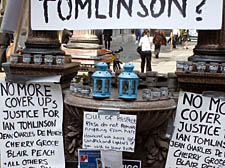| |

Tributes: A ‘shrine’ in the City to Ian Tomlinson, whose death is now being investigated |
G20 police seemed ‘up for it’
Even during peaceful demonstrations, police officers’ actions can be aggressive, argues solicitor Raj Chada
WHO would want to be a copper? If the past few days – when public order policing at the G20 summit and disturbances in Camden have been in the spotlight – show anything, it is the difficult nature of the job.
Officers on the ground often have to take split-second decisions that will be pored over by lawyers and journalists for months… and yet does that preclude this vital public service from proper scrutiny?
Take the G20 protests.
At Hodge Jones & Allen, we have received numerous complaints about the police behaviour at this event.
The police employed the tactic of “kettling” to segregate and control the crowd, containing demonstrators in certain areas.
The police effectively seal the area and won’t let anyone in or out. It is correct to say that this technique had been, to some extent, legally approved.
Yet further challenges are inevitable.
Surely the police now have to review this procedure and take a hard look and see whether this actually works in preventing disorder. (There was an infamous case in Camden where the police “kettled” football supporters into a pub for two hours, bar staff were ordered to continue to serve alcohol and the police refused to let anyone leave the pub. Needless to say, violence ensued in the pub.)
Corralling people into confined areas with the use of batons and riot shields does not produce the best in people who may not have had a high opinion of the police to start off with.
In my view, though, kettling is a symptom of a wider problem within public order policing, the culture and demeanour of officers towards protesters or activists.
Protests are regarded as a police headache and all are viewed as potential suspects. Even during peaceful demonstrations the officers’ attitudes can be shocking, rude, aggressive and condescending. What chance that this spills into violence during more tense confrontations?
This culture starts from the top. The briefings issued by the police, prior to G20, ramped up the tension, giving the idea that the police were “up for it”.
Police saying that there was bound to be trouble because of their “intelligence on anarchist groups” hardly reassured genuine protesters to attend. It certainly does not transmit to the officer on the front line the need for discipline and restraint.
We have since seen the footage of officers using batons, in particular against Ian Tomlinson who collapsed and died moments later.
The second baton attack on a female protester prompted swift action by the police to suspend the officer, however, reinforcing the perception of public order policing being out of control.
If something did go wrong in these cases, then only independent scrutiny and challenge will change behaviour.
That change will only occur if there is a candid look at what went wrong. Yet, the most troubling aspect of all of this is the response of the police after the event.
In chilling echoes of the De Menezes case, there was immediately misinformation about what happened.
Mr Tomlinson had “no contact” with the Met Police – demonstrators were throwing bottles as the police heroically protected him. Really? Is that what the footage shows?
The Independent Police Complaints Commission, responsible for launching inquiries into alleged police misconduct, initially said that there was no CCTV in the area.
Photos were published on Tuesday April 14 clearly showing at least two CCTV cameras in the area. Despite the complaints of many witnesses, does anyone really believe that the Met or the IPCC would have taken any action if this incident hadn’t happened to be caught on video? Would the official story not have stood and protesters’ accounts dismissed as “the usual suspects dissing the police”?
This raises fundamental questions about the independence of scrutiny and how complaints are dealt with.
Who would be a copper? Not me – it’s much too difficult. But because they have a difficult job does not mean that we should not ask these questions. Indeed, it is all the more reason to.
|
 |
|
 |
| |
| |